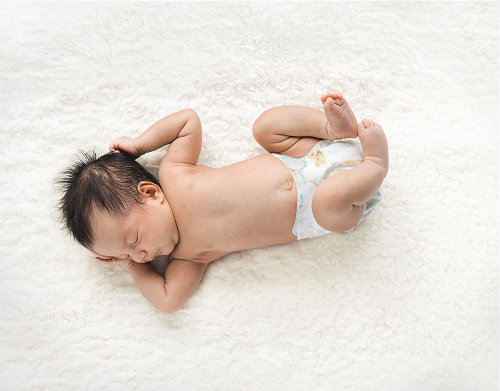Newborn milestones and development: The Senses
What newborns see, hear & feel
Young babies seem to grow even as you watch them. Not only does their birth-weight double in about five months, their ability to interact with their surroundings develops equally fast. Indeed, growing babies seem to be reaching out to their parents and the rest of the world with all their senses.
1. A sight to see
By four months, babies can focus their eyes well on objects all over the room, although most babies prefer to watch things that are about a yard away. Faces with their ever-changing expressions are still the most interesting sight for babies, but they now begin to follow all objects intently with their eyes. And since babies have an inborn preference for bright colours, you may want to add some vivid rainbow hues to the pastels most of us associate with a baby’s room.
2. Now hear this!
Listening is also becoming more important now for your baby, who delights in the sound of your voice as you talk, sing or hum. (By four months a baby knows if its parent or someone else is talking). You’ll notice that your baby may stop sucking to listen to a new sound, and may turn to look at you on hearing your approaching footsteps. A four- month-old will enjoy the sound of wind chimes or even the ticking of a clock and will probably delight in a music box fastened on the side of the crib.
3. Reach out and touch
Everyday now your baby will be concentrating on connecting sights and sounds with the sense of touch. At first, babies aren’t really aware that their hands are part of themselves. Infants will watch their hands pass before their eyes and laugh as one hand grasps the other. Gradually, babies begin to bat at crib toys and if their hands happen to touch one, may stop in surprise. By the fourth month, the reflex that causes clenched fists in infants disappears, and they are able to open, close and intertwine their fingers. Then, at five months, babies are able to reach for and grasp an object, transfer it from one hand to the other and finally bring it to the mouth for further exploration.
It’s exciting for babies to discover that they can have an effect on things. By taking an interest in things outside themselves they make an important step forward.
Do you know that an average baby will need 1057 nappy changes in the first 6 months? Get exclusive promotions and free diaper samples by joining the Huggies Club now! As a member, you can also gain exclusive access to the Huggies Forum and connect with experts to get more personalized pregnancy and parenting advices.
The information published herein is intended and strictly only for informational, educational, purposes and the same shall not be misconstrued as medical advice. If you are worried about your own health, or your child’s well being, seek immediate medical advice. You should never delay seeking medical advice, disregard medical advice, or discontinue medical treatment because of information on this website. Kimberly-Clark and/ or its subsidiaries assumes no liability for the interpretation and/or use of the information contained in this article. Further, while due care and caution has been taken to ensure that the content here is free from mistakes or omissions, Kimberly-Clark and/ or its subsidiaries makes no claims, promises or guarantees about the accuracy, completeness or adequacy of the information here, and to the extent permitted by law, Kimberly-Clark and/ or its subsidiaries do not accept any liability or responsibility for claims, errors or omissions.
Last Published* July, 2023
*Please note that the published date may not be the same as the date that the content was created and that information above may have changed since.

